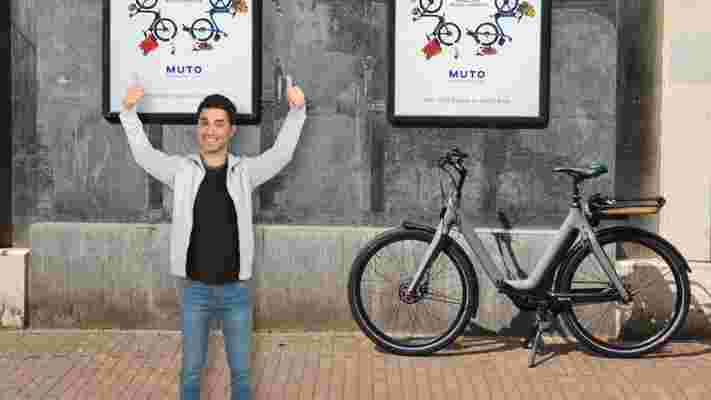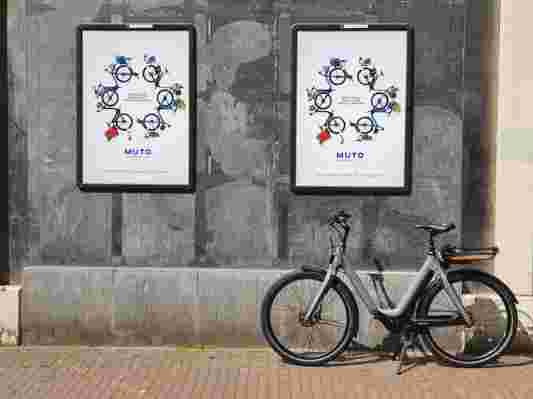
Welcome to Riding Nerdy , TNW’s fortnightly dive into bicycle-based tech, where we go into too much detail and geek out on all things related to pedal-powered gadgets.

When ebike startup Muto got in touch to tell us about their debut machine, also called the Muto, I jumped at the chance to use it as my daily commuter for a week — and boy I’m glad that I did.
My colleagues have reviewed quite a few ebikes here on TNW, but I’ve personally never had chance to get hands on with one and use it as my daily ride. Working in Amsterdam, I live on bicycles, but I’ve only ever ridden ebikes for a few hundred yards at test events. Ebike buying figures are on an upward trend, and industry experts expect the European market to triple in size over the next five years.
Getting a week on the Muto has opened my eyes to why these machines are becoming an increasingly popular mode of transport, and honestly, I think everyone should have one.


The top line
The Muto is built like a tank. It’s a utilitarian but handsome brute. After a few days of riding it, I sensed something was a little unusual about the Muto’s frame. As it turns out, the frame is glued and bonded rather than welded. If you’re alarmed at this and concerned that glue can’t possibly be as strong as a weld, don’t be. It’s a technique borrowed from the aerospace industry where glued alloy parts have been commonplace for years.
The upside is you get a clean looking frame with no visible welds. What’s more, when welded alloy frames fail, it tends to happen around tube joints and welds. In other words, I’m confident the Muto frame will with stand the rigors of abuse and life about town for many years to come.
Like many other bikes in this category, one frame is designed to fit a range of heights. If you’re exceptionally tall or short, this won’t be the bike for you. The Muto is designed to fit people 159 cm to 190 cm, which the company says is about 80% of European adults. So most people are covered.
Its position is classic town bike. For want of better words, you “ sit-up-and-beg ” like many other town bikes. It’s ultimately the most comfortable type of two-wheeler.
The rest of the build continued to fill me with confidence. It’s not uncommon to find low quality components on ebikes, they’re often used in an attempt to keep costs down, but the Muto is refreshingly well-equipped. It has 8-speed Shimano Nexus hub gears which require virtually no maintenance and operate flawlessly. The faultless hydraulic disc brakes, an absolute must for consistent year-round braking when fully loaded, are also supplied by the Japanese cycling giant.
Another big perk of the Muto is that it uses a Gates belt drive system rather than a chain. Belts might sound cheaper and perhaps less robust than chains, but that’s not the case. Belt drives have many upsides: they’re virtually inaudible, require no maintenance, and are not lubricated, meaning they stay spotlessly clean. There’s no chance of catching your beautiful beige chinos for them to be covered in oil here.
The Muto also features Schwalbe Big Apple tyres, which are robust, roll fast, and when run at slightly lower pressures than normal, are capable of smoothing out and retaining grip on very poor road surfaces. I took the Muto down some gravel hard-pack paths to see what would happen, and it goes as well as any fully rigid hybrid or mountain bike would — if not better because of the electrical assistance.
Power to the pedal
The Muto is a front wheel drive peal assist ebike. In my testing, it showed itself to have a real world range of between 20 miles (32 km) and 35 miles. Most of the time, I had it set to give me the biggest amount of electrical assistance. With this, I had to charge the battery every few days. This isn’t a problem at all though, because the battery is easily removable — it locks into the bike when in use.
Some other ebikes, particularly those focused on aesthetics, don’t offer removable batteries. If you live somewhere which prevents you from bringing the bike indoors, having a removable battery is an absolute must.
There are sensors on the crank that track the speed you’re pedaling, which then dictates how much assistance the front motor provides. With these systems, there will always be a tiny delay before the motor kicks in. With the Muto though, that delay was somewhere between one half of and one full pedal revolution. In reality this is a split second given that most people pedal more than one revolution per second.
The motor’ power delivery is smooth and progressive, there was no unexpected jerking or surging. Coupled to the big tires, the whole thing rides with a planted yet cloud like feeling. Coasting effortlessly over pavement, cobbles, tarmac, and whatever else lay in its path. Like other ebikes the Muto is limited to only provide electrical assistance up to 15 mph (25 kph).
The Muto is operated with a simple control panel on the left-hand side of the handlebars. Here you can increase or decrease the level of motor assistance, turn the lights on and off, and activate walk assist. That’s it. Nothing more, nothing less. It means you can hop on and ride, it’s a positively unencumbered machine. As a bike should be.
All in all, It makes it reliable, serviceable, and something that will stand the test of time. There’s no technology here that will age or runs the risk of breaking somewhere down the line. It also makes it a great ebike for someone who doesn’t want a hyper complex device.
In my opinion, for a bike designed to be adaptable and a utilitarian town tool, Muto still does a great job of blending clean aesthetics with practical simplicity. Which brings me to my next point.
The Muto is designed to be highly adaptable for real life use cases. It doesn’t call itself a replacement for your car, but there’s no reason it couldn’t be.
For this, the Muto has front and rear mounting points for a whole host of accessories. You can have front and rear racks, panniers, baskets, child seats, and so on. The best bit though, is the accessories lock to the bike to prevent theft and can be switched out in a matter of seconds.
As we were all in lockdown when I was testing the Muto, I did a couple of “commute simulations.” I packed the bike for things that I would need for a busy office day followed by a round of squash.
With the large rear basket, the Muto was easily able to carry my laptop, sports kit, and racket without hassle. When I wanted to pop around town a day later, I took off the basket for a more refined appearance and to remove some bulk.
Refreshingly simple
But what really impressed me, is the Muto’s overall simplicity. I get the feeling that lots of ebike makers nowadays are keen to squeeze as much tech as possible into their machines to set them apart from the competition. We’ve seen ebikes equipped with theft protection, GPS tracking, special apps, and so on. These are all great features, if you want and use them. If not, they just make the bike more expensive and complicated than it needs to be.
I should also mention the price, its starts from €1,699 (around $1,900). By the time you’ve thrown on some accessories though, this will maybe be closer to €1,800 ($2,000). But this is still a competitive price for such a well-built and equipped machine. So much so, it’s the ebike I’d recommend to people looking for something simple, to the point, reliable, and capable of carrying tonnes of luggage.
The fact this ebike is so well-thought-out should come as no surprise when you consider that the Muto bike was designed, developed, and made by a specialist crack team from Stella bikes. You might not have heard of Stella before you live outside the Benelux region, but the company claims it’s one of the market leaders when it comes to ebikes in the Netherlands. I’ve certainly seen hundreds of them in Holland.
Those Dutch folk know a thing or two about what makes a good town bike, and the Muto is certainly one of them. It’s a perfect example of ebikes are becoming so popular, I consider myself convinced.
* The Muto is currently only being delivered to the Netherlands, Germany, Belgium, and Denmark.